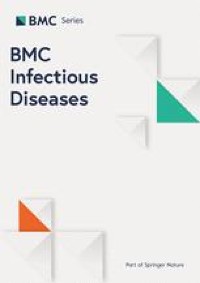Infection
HPV infection and vaginal microecological disorders in women with intrauterine adhesion: cross-sectional study in a Chinese population
Dreisler E, Kjer JJ. AsHerman’s syndrome: current perspectives on diagnosis and management. Int J Womens Health. 2019;11:191–8.
Google Scholar
Salzani AYD, Gabiatti JR, Bedone AJ, Monteiro IM. Prevalence of uterine synechia after abortion evacuation curettage. Sao Paulo Med J. 2007;125(5):261–4.
Google Scholar
Hooker AB, Lemmers M, Thurkow AL, Heymans MW, Opmeer BC, Brolmann HA, et al. Systematic review and meta-analysis of intrauterine adhesions after miscarriage: prevalence, risk factors and long-term reproductive outcome. Hum Reprod Update. 2014;20(2):262–78.
Google Scholar
Clarke MARA, Gage JC, et al. A large, population-based study of age-related associations between vaginal pH and human papillomavirus infection. BMC Infect Dis. 2012;12:33.
Google Scholar
Stanley MA. Epithelial cell responses to infection with human papillomavirus. Clin Microbiol Rev. 2012;25(2):215–22.
Google Scholar
Schaub AM, Pisarska MD, Wright KN. Intrauterine adhesions after Chlamydia infection with a levonorgestrel-releasing Intrauterine device in place. Obstet Gynecol. 2021;138(3):478–81.
Google Scholar
Onderdonk AB, Delaney ML, Fichorova RN. The human microbiome during bacterial vaginosis. Clin Microbiol Rev. 2016;29(2):223–38.
Google Scholar
Mitchell C, Marrazzo J. Bacterial vaginosis and the cervicovaginal immune response. Am J Reprod Immunol. 2014;71(6):555–63.
Google Scholar
Libby EK, Pascal KE, Mordechai E, Adelson ME, Trama JP. Atopobium vaginae triggers an innate immune response in an in vitro model of bacterial vaginosis. Microbes Infect. 2008;10(4):439–46.
Google Scholar
Gillet E, Meys JF, Verstraelen H, Bosire C, De Sutter P, TemMerman M, et al. Bacterial vaginosis is associated with uterine cervical human papillomavirus infection: a meta-analysis. BMC Infect Dis. 2011;11:10.
Google Scholar
Wright TC Jr, Dunton ML. 2006 consensus guidelines for the management of women with cervical intraepithelial neoplasia or adenocarcinoma in situ [published correction appears in J Low Genit Tract Dis. J Low Genit Tract Dis. 2007;11(4):223–39.
Google Scholar
He ZHKZ, Xu AQ. Human papillomavirus infection and vaccination. Zhonghua Yu Fang Yi Xue Za Zhi. 2018;51(1):106–12.
Wang L, He L, Chen J, Wei S, Xu H, Luo M. HPV and vaginal microecological disorders in infertile women: a cross-sectional study in the Chinese population. Virol J. 2022;19(1):137.
Google Scholar
Lukic ACC, Patella A, et al. Determination of cervicovaginal microorganisms in women with abnormal cervical cytology: the role of Ureaplasma urealyticum. Anticancer Res. 2006;26(6c):4843–9.
Google Scholar
Kyrgiou M, Mitra A, Moscicki AB. Does the vaginal microbiota play a role in the development of cervical cancer? Transl Res. 2017;179:168–82.
Google Scholar
Dun S, Liu C, Li N. Changes of Vaginal Microecology of Women with Intrauterine Adhesions. Int J Women’s Health. 2023;15:857–67.
Google Scholar
Dai Q, Hu L, Jiang Y, Shi H, Liu J, Zhou W, et al. An epidemiological survey of bacterial vaginosis, vulvovaginal candidiasis and trichomoniasis in the tibetan area of Sichuan Province, China. Eur J Obstet Gynecol Reprod Biol. 2010;150(2):207–9.
Google Scholar
Hu ZZW, Mu L, Kuang L, Su M, Jiang Y. Identification of cytolytic vaginosis versus vulvovaginal candidiasis. J Low Genit Tract Dis. 2015;19(2):152–5.
Google Scholar
Zhu BZWY, Xiang ZR. Vaginal cleanliness judgment standard of confusion and advice. Lab Med Clin. 2012;9(3):342–43.
Van Schalkwyk JYM, Yudin MH, et al. Vulvovaginitis: screening for and management of trichomoniasis, vulvovaginal candidiasis, and bacterial vaginosis. J Obstet Gynaecol Cancer. 2015;37(3):266–76.
Google Scholar
Group:CMAOaGBIDC. Expert consensus on clinical application of vaginal microecosystem assessment. Chin J Obstet Gynecol. 2016;51(10):721–23.
Zhu R, Gan L, Wang S, Duan H. A cohort study comparing the severity and outcome of intrauterine adhesiolysis for AsHerman syndrome after first- or second-trimester termination of pregnancy. Eur J Obstet Gynecol Reprod Biol. 2019;238:49–53.
Google Scholar
Kou L, Jiang X, Xiao S, Zhao YZ, Yao Q, Chen R. Therapeutic options and drug delivery strategies for the prevention of intrauterine adhesions. J Control Release. 2020;318:25–37.
Google Scholar
Yu D, Wong YM, Cheong Y, Xia E, Li TC. AsHerman syndrome–one century later. Fertil Steril. 2008;89(4):759–79.
Google Scholar
Liu NNZX, Tan JC, Liu S, Li BW, Xu WX, Peng L, Gu P, Li W, Shapiro R, Zheng X, Zhao W, Jiang YG, Chen D, Xu D, Wang H. Mycobiome Dysbiosis in Women with Intrauterine Adhesions. Microbiol Spectr. 2022;10(4):e0132422.
Google Scholar
Lee WL, Liu CH, Cheng M, Chang WH, Liu WM, Wang PH. Focus on the primary Prevention of Intrauterine Adhesions: current Concept and Vision. Int J Mol Sci 2021; 22(10).
Zhao X, Sun D, Zhang A, Huang H, Li Y, Xu D. Candida albicans-induced activation of the TGF-beta/Smad pathway and upregulation of IL-6 may contribute to intrauterine adhesion. Sci Rep. 2023;13(1):579.
Google Scholar
Chen X, Lu Y, Chen T, Li R. The female vaginal microbiome in Health and bacterial vaginosis. Front Cell Infect Microbiol. 2021;11:631972.
Google Scholar
Sideri M, Igidbashian S, Boveri S, Radice D, Casadio C, Spolti N, et al. Age distribution of HPV genotypes in cervical intraepithelial neoplasia. Gynecol Oncol. 2011;121(3):510–3.
Google Scholar
Liu Z, Kong Y, Gao Y, Ren Y, Zheng C, Deng X, et al. Revealing the interaction between intrauterine adhesion and vaginal microbiota using high–throughput sequencing. Mol Med Rep. 2019;19(5):4167–74.
Google Scholar
Di Donato V, Caruso G, Petrillo M, Kontopantelis E, Palaia I, Perniola G et al. Adjuvant HPV vaccination to prevent recurrent cervical dysplasia after Surgical Treatment: a Meta-analysis. Vaccines 2021; 9(5).
Di Donato V, Caruso G, Bogani G, Cavallari EN, Palaia G, Perniola G et al. HPV vaccination after primary treatment of HPV-Related disease across different Organ Sites: a Multidisciplinary Comprehensive Review and Meta-Analysis. Vaccines 2022; 10(2).
Georgescu SR, Mitran CI, Mitran MI, Caruntu C, Sarbu MI, Matei C, et al. New Insights in the pathogenesis of HPV infection and the Associated carcinogenic processes: the role of chronic inflammation and oxidative stress. J Immunol Res. 2018;2018:5315816.
Google Scholar
Zhang W, Yuan Y, Huang G, Xiao J. Potential Molecular Mechanism of Guishen Huoxue Decoction against Intrauterine Adhesion Based on Network Pharmacology. Evid Based Complement Alternat Med 2022; 2022:4049147.
Wei W, Xie LZ, Xia Q, Fu Y, Liu FY, Ding DN, et al. The role of vaginal microecology in the cervical cancer. J Obstet Gynaecol Res. 2022;48(9):2237–54.
Google Scholar

